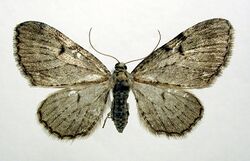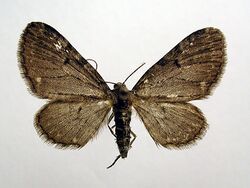Biology:Eupithecia actaeata
| Eupithecia actaeata | |
|---|---|

| |

| |
| Scientific classification | |
| Domain: | Eukaryota |
| Kingdom: | Animalia |
| Phylum: | Arthropoda |
| Class: | Insecta |
| Order: | Lepidoptera |
| Family: | Geometridae |
| Genus: | Eupithecia |
| Species: | E. actaeata
|
| Binomial name | |
| Eupithecia actaeata Walderdorff, 1869[1]
| |
| Synonyms | |
Eupithecia actaeata is a Eurasian species of moth of the family Geometridae.
Description
E. actaeata has a wingspan of 19–24 mm,[3] with broader wings than is typical for Eupithecia species.[2] Both wing pairs are grey,[2] brownish-grey,[3] or brown,[4] with somewhat paler hind- than forewings.[3][2]
Subspecies
- Eupithecia actaeata actaeata
- Eupithecia actaeata praenubilata Inoue, 1958
Distribution
Europe
Within Europe, E. actaeata is found France eastwards, where it is widely distributed in northern, central and eastern Europe,[3] and has only local distribution south of the Alps.[5]
Asia
In Asia, E. actaeata ranges from the southern Urals to Mongolia,[6] China (Qinghai and Shaanxi), Japan , the Russian Far East, Taiwan[3] and Korea.[2][4]
Habitat and host plants
E. actaeata has been found at altitudes from sea level up to 2000 m in Europe[3] and between 1600 and 3000 m in China.[2] It is found in forests with a presence of Actaea spicata (baneberry),[3][5] its main host plant. In north-western Europe, it is found predominantly in closed spruce forests.[7] In Asia, it has been found on another species of Actaea.[2] Other known host plants are Thalictrum aquilegiifolium and Thalictrum flavum.[3] Viburnum opulus has also been mentioned in scientific literature,[3] but might be erroneous.[8]
Life cycle
There are two generations per year with adults on wing from the end of May to August. Larvae can be found from June to September. It overwinters as a pupa.
References
- ↑ Yu, Dicky Sick Ki. "Eupithecia actaeata Walderdorff 1869". Taxapad. http://www.taxapad.com/local.php?taxonidLC=82839325.
- ↑ 2.0 2.1 2.2 2.3 2.4 2.5 2.6 2.7 2.8 Mironov, Vladimir; Galsworthy, Anthony Charles (1 November 2013) (in en). The Eupithecia of China: A Revision. BRILL. pp. 232–233. ISBN 978-90-04-25453-4. https://brill.com/display/title/24316. Retrieved 22 January 2023.
- ↑ 3.0 3.1 3.2 3.3 3.4 3.5 3.6 3.7 3.8 Mironov, Vladimir (2003) (in en). Larentinae II: (Perizomini and Eupitheciini). Brill. pp. 174–175. ISBN 978-90-04-30863-3. https://brill.com/display/title/23991. Retrieved 22 January 2023.
- ↑ 4.0 4.1 Choi, Sei-Woong; Kim, Sung-Soo (30 April 2015). "New Records of Seven Eupithecia (Lepidoptera: Geometridae) from Korea". Animal Systematics, Evolution and Diversity 31 (2): 132. doi:10.5635/ASED.2015.31.2.128. https://koreascience.kr/article/JAKO201514751394256.page. Retrieved 22 January 2023.
- ↑ 5.0 5.1 Wagner, Wolfgang. "Eupithecia". http://www.pyrgus.de/Eupithecia_en.html.
- ↑ Mironov, Vladimir; Galsworthy, Anthony Charles (5 March 2014). "A survey of Eupithecia Curtis, 1825 (Lepidoptera, Geometridae, Larentiinae) in Mongolia with descriptions of two new species". Zootaxa 3774 (2): 101–130. doi:10.11646/zootaxa.3774.2.1. PMID 24871410.
- ↑ Hydén, Nils (1990). "Baptria tibiale och Eupithecia actaeata (Lep., Geometridae) i Nordvästeuropa – utbredning, biologi, äggläggning och habitatval". Entomologisk Tidskrift 111 (1): Abstract. https://www.sef.nu/download/entomologisk_tidskrift/et_1990/ET%201990%201-15w.pdf.
- ↑ Ellis, W.N.. "Eupithecia actaeata – Plant Parasites of Europe". https://bladmineerders.nl/parasites/animalia/arthropoda/insecta/lepidoptera/ditrysia/apoditrysia/macrolepidoptera/geometridae/larentiinae/eupitheciini/eupithecia/eupithecia-actaeata/.
External links
Wikidata ☰ Q142163 entry
 |

